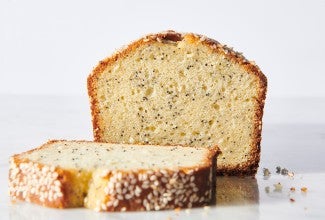Turns out, crusts aren’t just for bread
Your cakes deserve a crust that’s crispy, crunchy, or just plain sparkly.


Pastry chef Natasha Pickowicz’s cakes are undeniably gorgeous. They’re crowned with unexpected adornments, like magenta radicchio, or frosted with slate gray black sesame frosting for a modern twist.
But while she clearly has a knack for striking visuals, my favorite of her cake tricks might be one that’s hidden underneath the surface. While flipping through her new book, More Than Cake, a tiny tip tucked away in a recipe for vanilla loaf cake stuck out to me: “A coating of cooking spray on the parchment [lining the pan] will glue any number of crunchy toppings to the sides of your cake, creating an outrageously yummy crust. Small seeds like flax and sesame and crunchy sugars like turbinado add texture and visual interest.”
(Heads up: At King Arthur, we only recommend the cookbooks that we, as bakers, truly love. When you buy through external links on our site, we may earn an affiliate commission.)
Natasha explained the various benefits of this trick to me. Foremost, it allows you to build more flavor into your baked goods. “[With crust treatments], you’re able to accent the recipe with another version of that ingredient in the crust itself,” says Natasha. As she often asks herself: “Basically, how can I take the personality of the cake and extend it in an extra way to inject flavor?”

There’s visual appeal as well: Some ingredients, such as finishing sugars like turbinado sugar or sparkling sugar, add a little glitz and beauty to the final bake, elevating a potentially humble quick bread or unfrosted single-layer cake. But there’s also a practical benefit.
“Have you ever had a piece of cake that was kind of dry around the edges, like it was exposed to air?” asks Natasha. “I found that coating the cake in crunchy small seeds like sesame seeds or baking the cake with a crust of turbinado sugar allows it to hold in that moisture, and I think it extends the shelf life of these baked goods.”
So which ingredients does Natasha like to use for cake crusts? “I love seeds and seed mixes,” she recommends, as evidenced by her use of black and white sesame seeds to coat the outside of More Than Cake’s date cake. “Even finely chopped nuts work. Really, anything that's going to adhere to a pan that's been coated in nonstick spray or brushed with a bit of melted butter.” This includes coarse sugars, though Natasha cautions against using molasses-infused brown sugars that are slightly damp, as they can be difficult to sprinkle evenly into the pan to coat. If you’re using nuts, she recommends toasting them ahead of time: “Again, it’s a very quick step that builds flavor.”

Start by coating the pan with a thin, even layer of fat. (If the recipe calls for lining with parchment, coat the parchment-lined pan.) Natasha uses a wide range of fats, including melted butter, coconut oil, vegetable oil, olive oil, and nonstick spray. The key is to get a thorough, even coating across the whole pan. (A pastry brush is helpful here.) “I like nonstick spray for that very reason, because it gives just the right amount of stickiness for things to adhere to it,” she says.
Add a few tablespoons of your chosen crust treatment to the bottom of the pan — finely chopped nuts, seeds, coarse sugar, etc., using a little more than you think you’ll need. Then tilt the pan in all directions, shaking gently to coat the bottom and walls of the pan. No need to pat into place — simply let gravity do the work. Then gently tap out any excess that hasn’t adhered to the pan. Fill with batter and bake as the recipe directs.
Inspired? You can try this technique with Tahini Poppy Seed Pound Cake, which already features a coating of sesame seeds on the outside of the loaf to complement the nutty flavor notes of tahini in the batter.
Then venture out by applying this technique to recipes that don’t include this tip. Spiced Carrot Snacking Cake already features chopped walnuts or pecans folded into the batter — why not use finely chopped toasted nuts to coat the outside as well? Alternately, you could coat the bottom of this Black Sesame Halva Coffeecake in a layer of toasted black sesame seeds to really amp up the flavor and texture.

You can use this trick for muffins too. Natasha uses a coating of millet on her millet, parsnip, and chocolate chunk muffins (pictured above); you could experiment with millet or try a flax seed crust on these Blueberry Flax Muffins, which would be a nice crunchy contrast to the juicy berries within. Simply apply the same method to the wells of a muffin pan.
Me? I’ll be adding a dusting of glittering sparkling sugar to the outside of everyday Banana Bread to make this common loaf feel a little more special.
For more baking advice from Natasha, see our previous post: Things bakers know: Bake your layer cakes in a sheet pan.
Cover photo (Tahini Poppy Seed Pound Cake) and food styling by Liz Neily.


